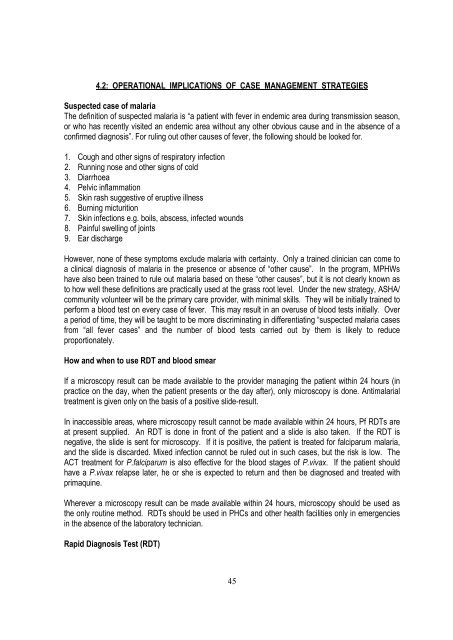training module for medical officers primary health centre - NVBDCP
training module for medical officers primary health centre - NVBDCP
training module for medical officers primary health centre - NVBDCP
- No tags were found...
You also want an ePaper? Increase the reach of your titles
YUMPU automatically turns print PDFs into web optimized ePapers that Google loves.
4.2: OPERATIONAL IMPLICATIONS OF CASE MANAGEMENT STRATEGIESSuspected case of malariaThe definition of suspected malaria is “a patient with fever in endemic area during transmission season,or who has recently visited an endemic area without any other obvious cause and in the absence of aconfirmed diagnosis”. For ruling out other causes of fever, the following should be looked <strong>for</strong>.1. Cough and other signs of respiratory infection2. Running nose and other signs of cold3. Diarrhoea4. Pelvic inflammation5. Skin rash suggestive of eruptive illness6. Burning micturition7. Skin infections e.g. boils, abscess, infected wounds8. Painful swelling of joints9. Ear dischargeHowever, none of these symptoms exclude malaria with certainty. Only a trained clinician can come toa clinical diagnosis of malaria in the presence or absence of “other cause”. In the program, MPHWshave also been trained to rule out malaria based on these “other causes”, but it is not clearly known asto how well these definitions are practically used at the grass root level. Under the new strategy, ASHA/community volunteer will be the <strong>primary</strong> care provider, with minimal skills. They will be initially trained toper<strong>for</strong>m a blood test on every case of fever. This may result in an overuse of blood tests initially. Overa period of time, they will be taught to be more discriminating in differentiating “suspected malaria casesfrom “all fever cases” and the number of blood tests carried out by them is likely to reduceproportionately.How and when to use RDT and blood smearIf a microscopy result can be made available to the provider managing the patient within 24 hours (inpractice on the day, when the patient presents or the day after), only microscopy is done. Antimalarialtreatment is given only on the basis of a positive slide-result.In inaccessible areas, where microscopy result cannot be made available within 24 hours, Pf RDTs areat present supplied. An RDT is done in front of the patient and a slide is also taken. If the RDT isnegative, the slide is sent <strong>for</strong> microscopy. If it is positive, the patient is treated <strong>for</strong> falciparum malaria,and the slide is discarded. Mixed infection cannot be ruled out in such cases, but the risk is low. TheACT treatment <strong>for</strong> P.falciparum is also effective <strong>for</strong> the blood stages of P.vivax. If the patient shouldhave a P.vivax relapse later, he or she is expected to return and then be diagnosed and treated withprimaquine.Wherever a microscopy result can be made available within 24 hours, microscopy should be used asthe only routine method. RDTs should be used in PHCs and other <strong>health</strong> facilities only in emergenciesin the absence of the laboratory technician.Rapid Diagnosis Test (RDT)45
















